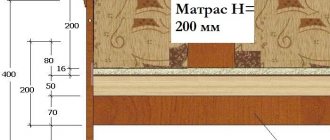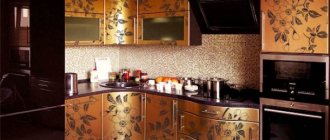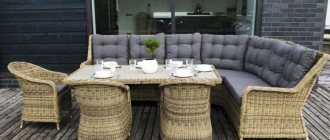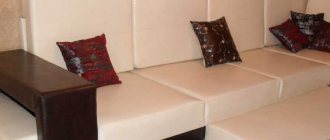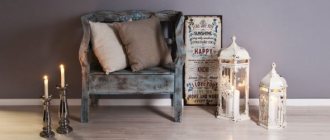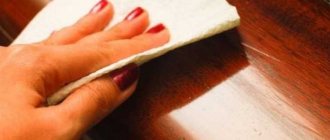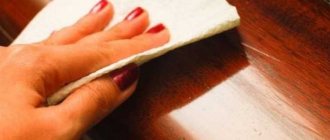Natural patina is a change in the color of a wooden surface as a result of a long period of time, oxidation and contact with hands.
Artificial patina on wood is a plaque on the coating of interior items that appears as a result of forced aging. This method of decoration gives newly made furniture an antique effect and protects it from wear, and prolongs the life of old furniture.
What is patination
Patination of furniture is used to give it a fashionable decorative effect of antiquity. Wooden doors and floors, windows, and picture frames are also patinated. Artificial patina comes in dark, colored, metallic and white. This method can be used to restore kitchen furniture, bedroom sets, and dining sets.
The most popular option is aged white, patinated furniture for interiors in country, Provence and Mediterranean styles. Patination with milk paint and gilding is widely used. This decor looks especially impressive on furniture sets in a classic style.
The process of patination of furniture made of natural wood involves applying special compounds to its surface. They are applied to corners, edges, and in relief recesses. This is how hardwood is processed: oak, beech, ash, birch, etc.
And if under natural conditions the aging of furniture facades, the nobility of paint darkened and peeling off over time is only possible if we are talking about natural wood, then innovative techniques make it possible to achieve similar effects on MDF or chipboard.
Craquelure technique
Additional cracks, the so-called “craquelures,” provide the wood with a high decorative effect. To do this, use a special varnish, the main feature of which is cracking. In order for the created cracks to become noticeable, they are rubbed with a contrasting composition. Craquelure is often considered decoupage.
The surface is treated only with a primer; the use of a brush or sandpaper is prohibited. The first layer is applied with craquelure/decoupage varnish, which is selected according to the color of the wood. If required, a second layer is applied to make the nuance brighter.
A layer of decoupage varnish is applied to the still uncured varnish, which partially cracks during drying, forming cracks characteristic of the old coating. The finished surface is rubbed down. To consolidate the result obtained, the part is coated with a layer of varnish (most often shellac class).
- Artificial aging
- Patina on wood
- Detailed description of the compositions
- Patina technology
A perfectly clean and glossy surface is a sign of the newness of an interior item or furniture. But aged wood is often valued more highly, especially when it comes to the classic furnishings of a room. Artificial patination of wood is a quick way to get an aged surface on any wooden surface and not only.
Initially, patina was an oxidized copper layer on furniture, mirror moldings, columns and other architectural elements in the palaces and estates of wealthy people. This effect was achieved after many years of service of the item. The film has a bluish or greenish tint.
Over time, patina began to be called any plaque that appears on metal and wooden surfaces.
Tools and materials
You can artificially age furniture at home. This will require some tools and materials.
To apply paint you will need several brushes - for each composition. For preliminary sanding, use sandpaper. When it comes to restoring wooden facades or countertops, a grinding machine is used to prepare the slabs. To wipe down the decorative layer, you will need a dry rag.
To increase the adhesive properties of the surface, surface priming is needed. The basic decorative material, onto which a patina is subsequently applied, is acrylic paint or stain.
The next layer of paint is patina, of which little will remain as a result. In order to further protect the furniture, the patina is coated with varnish. For an antique effect, choose a matte varnish.
For work at home, it is better to use safe water-based acrylic compounds. They are quite durable and easy to work with.
Varieties of compositions and consistency
Previously, mechanical action was used to artificially age furniture, giving furniture a noble antique look. Interior items were kept in rooms with high humidity, rubbed and scratched. Innovative methods allow you to achieve the desired effect in the shortest possible time and in various ways.
Patina for wood, depending on consistency, can be of the following types:
| Thick. | Paste-like compositions, base and finishing, oxidizing the surface being treated with the effect of gilding or rust. |
| Liquid. | Varnishes that are often used as a topcoat to achieve a yellow tint. |
| Dyes. | Patination with acrylic paints is used for relief and carved furniture made of natural wood, MDF and chipboard. The stain is only suitable for natural wood. |
stain
The easiest and most affordable way to make a patina on wood is to treat it with stain. It penetrates deeply into the wood and protects it from moisture, UV rays, mold, and pests. Varieties:
- Water stain does not require a solvent. This coating has an additional effect, because the wood fibers rise after processing, and the structure of the material becomes more visible. The composition allows you to give the product a shade of valuable wood.
- Alcohol stain is a solution of aniline dye in ethanol. In addition to being decorative, the coating has an antiseptic function. The composition dries too quickly, so it is used for small surfaces or applied with a spray bottle.
- Oil stain is coloring pigments dissolved in linseed oil. The substance evenly covers the wood, does not lift the fibers, but emphasizes the pattern of natural wood. Diluted with white spirit.
Stains can have different colors. With their help, it will be possible to imitate the gray or greenish coating that appears on the surface of an old tree. They are not used for processing MDF and chipboard, and are not combined with silver and gold plating or craquelure.
Wax
Water-based wax patina in the form of a paste and finishing vintage wax are popular as finishing coatings. Wax-based paints dry slowly and are easy to rub. They are used for processing relief and textured slabs, cracks to obtain the effect of gilding, silvering, and bronze coating.
Wax pastes are made by mixing natural wax with a metallic pigment. They have good adhesion to wood and plastic, which is used to laminate MDF.
The colorless wax composition leaves a pearlescent sheen on the surface. Wax is used to retouch, restore and decorate old furniture. The composition is applied with a cotton rag or brush, rubbed in, and then polished with a rag, removing excess. The wax coating dries within 24 hours.
Wax paint can be used to tint unpainted and unprimed wood, emphasizing its structure and protecting the surface from moisture.
Acrylic
Acrylic paints for patination are suitable for processing natural wood, laminated MDF or chipboard sheets. They come in a variety of shades with individual effects. Acrylic paints imitate gray, beige, green and blue patina, rust, darkening, and fading. You can patina with acrylic the entire slab or only the relief decorative elements, monograms, and frames. For this purpose, paint with a gilded or blackened effect is used.
Surface treatment is possible in the following way. Base paint of the selected color is applied to the entire area of the product or only to the protruding parts. Excess is removed with rags. If necessary, apply another layer, shade in places and allow to dry completely. Use sandpaper to create abrasions and fix them with varnish.
Bitumen
Bitumen is used for aging, painting, and giving patina effects. It consists of concrete polymer, turpentine or white spirit. Bitumen can also be water-based. The substance has a special consistency, which greatly simplifies its application. If desired, you can get not only a thin coating of gilding, but also active gilding. You can darken the recesses of the threads and monograms with black or brown bitumen. The substance is applicable in the craquelure technique.
It is applied with a swab or brush, dried at room temperature for 6 hours or using a hair dryer. Then coated with shellac.
It is also possible to patina wood using bitumen wax. It is used in the gilding process to dull the shine and give the gilding a touch of antiquity. Wax-based bitumen is applied with a cotton swab. Dries within 24 hours.
Advantages of patinated furniture
The undoubted advantages of furnishings processed in this way include practicality, durability, uniqueness and accessibility.
Since the colors of the headset are not uniform, the appearance itself will look harmonious with minor abrasions and minor flaws that inevitably arise during use.
There is no need to worry, the beauty of the furniture will not suffer from external unfavorable factors. This is a question of practicality.
As for durability, the composition with which the furniture is treated has protective properties, makes it moisture-resistant and resistant to temperature changes (which, as you know, is not uncommon when cooking). The patinated set will look luxurious for many years and will invariably delight all family members with its impeccable appearance.
Regarding uniqueness, hand-made patination will add a special atmosphere to your home. As you know, antiques are accessible to select segments of the population, so the achievements of modern technologists in terms of artificial aging of objects make it possible for a wide range of lovers to purchase antique furniture.
Applying patina to wood with your own hands
Do-it-yourself patination of wood begins with preparing the surface, and only after that the coloring composition is applied. It is important to follow safety precautions when working. Work must be carried out outdoors using protective equipment.
Preparatory stage
First of all, it is necessary to remove traces of old varnish and paint from the slab being treated with a wire brush or sandpaper. Laminate furniture is brushed using sandpaper.
After this, restoration is carried out. Using a special putty, deep damage is repaired, dried, and sanded again with sandpaper.
Then you need to apply a wood primer to the furniture and leave it to dry for 10 hours. To prepare the laminated coating, a special adhesive insulator is first used, and then a colorless polyurethane primer is used.
Using stain
The stain application process is simple. First, soft wood fibers are removed from the furniture being treated with a wire brush. Then, manually (with a brush, roller or sponge) or using a spray bottle, cover it twice with stain of the selected shade.
For more uniform application, the surface can be moistened with warm water. The result is secured with wax or shellac. The stain can work as a base coat, which is then topped with a layer of patina paint with a metallic sheen.
You can achieve more uniform coloring with the help of a conditioner, which will fill all the unevenness on the surface of the material. It is applied every 20 minutes until the composition stops being absorbed. Then wait 30 minutes and apply stain.
Classic way
Patina is applied to wood using the following method:
- Apply a base layer of acrylic paint of the desired shade to the slab. You can apply the composition evenly or in rough strokes. Leave to dry for 24 hours.
- Using sandpaper, carefully rub three layers of paint in some places for an aging effect, and polish with a rag.
- Apply another layer of acrylic paint. It can be a different shade or with a metallic sheen. Shade it, rub it again with sandpaper and dry it.
- Cover the product with a layer of matte acrylic varnish and leave for 6 hours until completely dry.
Types of patina
The following types of patina are distinguished:
- Shellac varnish. When working with varnish, a sponge or brush is used. Depending on the number of layers applied, the color varies from golden to transparent red.
- Acrylic patina for wood. It's acrylic paint. The least complicated in practice and ideally suited for apartment conditions. Acrylic patina is applied with a brush. The advantage is the large number of colors that can be used to tint the product. If necessary, repainting is done to achieve the desired shade.
- A bitumen-based varnish is applied to the furniture, the excess of which can be easily removed with white alcohol. The varnish is absorbed into the pores, creating an antique effect. This patina is dark in color. Shellac varnish will help preserve the result.
- Waxy patina. It finds its application, in addition to patination of wood, in order to emphasize the structure of the wood and tint it. It hardens for a long time, which ensures comfortable DIY work. Wax patina should be applied when the structure of the material needs to be revealed. Most often used for small parts made of oak and ash.
- similar to wax, but more versatile.

